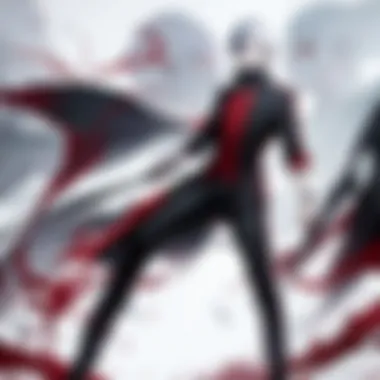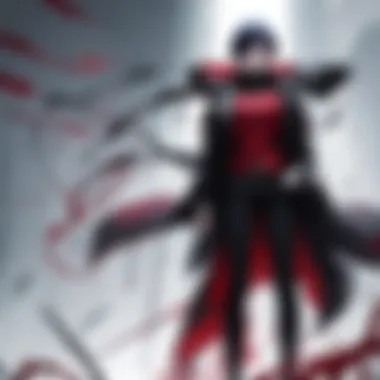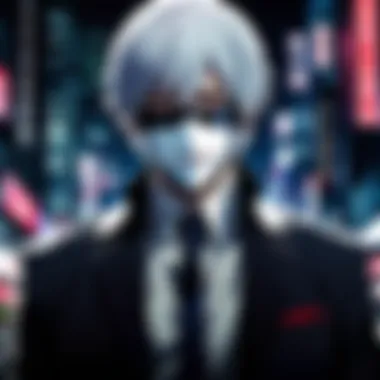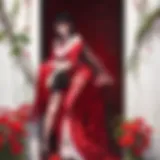Exploring the Impact of Tokyo Ghoul on Hulu


Prologue to the Series
Tokyo Ghoul is a compelling blend of horror, action, and psychological drama that captured the hearts of anime fans worldwide. Originally a manga created by Sui Ishida, it first hit the shelves in 2011 before making its transition to anime in 2014. The storyline is set in a dystopian Tokyo, where flesh-eating ghouls exist alongside unsuspecting humans. This duality forms the crux of the narrative, exploring complex themes of identity, survival, and morality.
The manga's popularity soared, leading to a diverse media franchise, including spin-offs, video games, and of course, the anime adaptations available for streaming on platforms like Hulu. Viewers are drawn not just to the action but also to deep character development and philosophical questions posed throughout the series.
When it comes to reception, Tokyo Ghoul garnered mixed reviews upon its initial release. While some praised its intricate storylines and emotional depth, others critiqued its pacing and some liberties taken with the source material. Nonetheless, it created quite a buzz, with its haunting visuals and gripping character arcs that resonate even with those unfamiliar with manga.
In summary, Tokyo Ghoul stands as a hallmark of modern anime and manga, attempting to bridge the gap between horror and humanity, a feat few narrative endeavors manage to accomplish.
Preface to Tokyo Ghoul
The complex world of Tokyo Ghoul holds undeniable significance in the anime scene. This series not only captivates viewers with its gripping plotlines but also invites deeper contemplation on themes like identity, humanity, and the perennial struggle between good and evil. The show stands as a cornerstone for discerning audiences looking to explore a darker side of anime, which diverges from the more traditionally upbeat narratives often seen in mainstream offerings.
Overview of the Series
Tokyo Ghoul, created by Sui Ishida, first appeared in 2011 as a manga and swiftly transitioned to anime in 2014. The series is set in an alternate reality where flesh-eating ghouls coexist with humans, masking their predatory nature amidst normal life. The protagonist, Kaneki Ken, is thrust into this harrowing world after a fateful encounter, forcing him to grapple with his newfound existence as a half-ghoul, half-human. Not merely a saga of survival, it delves into the existential crises that arise as Kaneki journeys through various conflicts, both internal and external.
This duality in Kaneki's character acts as a mirror reflecting fears, desires, and moral ambiguities. The show doesn't shy away from showcasing graphic violence and psychological turmoil, pushing boundaries among mainstream anime while also encouraging intense viewer engagement. By examining the intricate plot alongside Kaneki's evolution, fans gain insight into what it means to challenge societal norms and the weight of labels imposed by others.
The Global Reach of Anime
Anime, particularly titles like Tokyo Ghoul, has transcended cultural and geographical barriers over the years. From humble beginnings in Japan, anime has burgeoned into a global phenomenon, with streaming platforms such as Hulu playing a pivotal role in making diverse series accessible to international audiences. Today, discussions about Tokyo Ghoul can be easily found on platforms like Reddit and social media sites, where fans worldwide dissect episodes and character arcs.
The appeal of Tokyo Ghoul lays not solely in its aesthetic or storyline, but also in the way it encapsulates universal themes of fear, acceptance, and the innate human struggle for belonging. The subtleties of the characters' experiences resonate deeply with viewers, creating a shared space for empathy and understanding. For many, finding Tokyo Ghoul on Hulu is akin to stumbling upon an intricately woven tapestry of narratives that speaks to their very core, making it a beloved series among anime enthusiasts everywhere.
"Tokyo Ghoul serves as a testament to the cultural evolution of anime, illustrating how stories can transcend their roots, finding new life and understanding globally."
By laying the groundwork through this introduction, we can explore further aspects revolving around Tokyo Ghoul, showcasing its narrative depth, rich character development, and significant cultural impact.
Tokyo Ghoul on Hulu
The series Tokyo Ghoul has carved out a unique niche within the anime community. Its presence on Hulu marks a pivotal entry point for fans, both new and old. This platform offers a distinct space where the show's rich narrative and profound themes can engage a wider audience. Hulu's accessibility has breathed fresh life into the series, facilitating discussions and analyses that contribute to its cultural footprint.
Availability and Accessibility
Tokyo Ghoul's availability on Hulu is essential for both serious viewers and casual fans. The show can be streamed easily, allowing audiences to dive straight into Kaneki Ken's tumultuous journey. Being a subscriber to Hulu provides seamless access to all episodes without interruptions from ads. That’s a noteworthy benefit compared to other platforms that may introduce breaks or additional fees.
Moreover, Hulu allows users to download episodes for offline viewing, which is a game-changer for fans who want to indulge in late-night binges or travel without relying on Wi-Fi. In addition, the platform regularly updates its library, ensuring that viewers are not left hanging when seeking to rewatch episodes or explore related content.
User Demographics and Trends
The demographic trends reveal a fascinating picture. According to various reports, Tokyo Ghoul attracts a diverse audience, with a significant number of viewers ranging from late teens to early thirties. This age group often has not only a love for anime but also for deeper storytelling that challenges norms and delves into darker themes.
Interestingly, conversations on platforms like Reddit and Facebook about the series highlight an increase in interest from an international audience as well. It’s not just confined to Japan; Tokyo Ghoul has sparked fandom communities across continents. The discussions revolve around character arcs, moral dilemmas, and the philosophical questions raised in the series.
"The intense character development within Tokyo Ghoul resonates with many, especially those navigating their own identities."
This connection has made Tokyo Ghoul a topic of interest in academic and cultural discussions, painting it as a work deserving of deeper examination. The balance between horror and humanity has stirred curiosity and even study among those looking to uncover the broader implications of the narrative.
In summary, the themes and storytelling intricacies that Tokyo Ghoul presents on Hulu create a noteworthy experience. They foster engagement among viewers, which not only helps to grow its dedicated fandom but also enrich the cultural landscape of anime.


Narrative Structure and Themes
The narrative structure and themes of Tokyo Ghoul are fundamental in articulating the essence of the series. They navigate the labyrinth of identity and humanity, providing depth to the characters and the storyline. This section dissects how these components interact, establishing a profound connection with the audience.
Exploring Identity and Humanity
Tokyo Ghoul scrutinizes the concept of identity, pulling its viewers through the psychological turmoil experienced by its protagonist, Kaneki Ken. Faced with the existential crisis of being half-human and half-ghoul, Kaneki embarks on a journey that reflects a struggle many face in the reality: the search for self amid overwhelming circumstances. This duality serves as a mirror, urging the audience to confront their own identities. It’s not merely about surviving in a world that seeks to categorize individuals as either ghouls or humans; rather, it’s about soulful introspection and acceptance.
The series poses challenging questions about the nature of humanity: What defines us? Is it our actions, our feelings, or the roles society forces us into? Kaneki’s evolution from a meek student to a figure of profound complexity emphasizes this exploration, as he grapples with the powers of his ghoul side while retaining his human emotions. The emotional weight behind such transformation makes viewers empathize with him, as they recognize their own vulnerabilities within this narrative.
Moreover, through supporting characters like Touka Kirishima and Shuu Tsukiyama, the series unravels varied dimensions of identity—illustrating how personal experiences shape one’s perspective on themselves and others. The storytelling here highlights how society's often rigid classifications can lead to isolation, leading to an enriching theme of acceptance and understanding among the characters.
The Duality of Existence
The theme of duality runs rampant throughout Tokyo Ghoul. It doesn’t shy away from darkness; rather, it embraces it as an integral part of existence. Each character embodies this dual expression, particularly Kaneki, who constantly oscillates between his human emotions and ghoul instincts. His struggles serve as a compelling narrative device, illustrating how the line can blur between good and evil, sanity and madness.
This portrayal parallels philosophical discussions on dualism, indicating that one cannot exist without the other. The creatures that the series depicts—ghouls—are not merely villains. They symbolize the fears and desires that haunt individuals, presenting the notion that we all harbor dark facets within us. As Kaneki grapples with these elements, he unveils the truth about human nature: fragility and resilience often coexist.
Additionally, the juxtaposition of ghoul culture against the human world fosters a fascinating exploration of societal norms. This divide encourages viewers to contemplate their reactions to the "other" - the unknown can often manifest as fear or prejudice. By crafting a world where the lines between humanity and monstrosity continuously cross and overlap, Tokyo Ghoul catapults its audience into a web of moral ambiguity, encouraging reflection on their own perceptions of right and wrong.
"Tokyo Ghoul challenges the very essence of what it means to be human, leaving the audience questioning whether monstrosity resides in the form or in the actions."
As one navigates through these thematic intricacies, it becomes evident that the narrative is woven with threads that resonate deeply with a broad audience. The complexities of identity and the duality of existence are not just plot devices but fundamental reflections of the human experience, elevating Tokyo Ghoul from simple entertainment to a philosophical exploration of life itself.
Character Analysis
Character development in Tokyo Ghoul serves as the cornerstone of its narrative, helping to shape each thematic element and emotional impact throughout the series. This meticulous attention to character arcs not only makes the storyline rich but also offers viewers a chance to relate closely to the struggles and complexities faced by individuals in an alien world. The lessons learned through the characters create a deep connection with the audience, inviting them to reflect on the complexities of identity, morality, and humanity itself.
Kaneki Ken: The Reluctant Hero
Kaneki Ken stands as the embodiment of Tokyo Ghoul’s intricate exploration of transformation and self-identity. Initially a shy and unassuming college student, Kaneki's life takes a drastic turn after a fateful encounter leaves him as a half-ghoul. His journey from naivety towards plunging into the dark reality of ghouls is a compelling dive into the reluctant hero trope. He grapples with his duality, struggling to come to terms with his ghoul heritage while desperately trying to cling to his human side.
This push-pull between his two lives epitomizes his eternal conflict and paints a vivid portrait of self-discovery in harrowing circumstances. Viewers observe Kaneki's transformation not just in his physicality but in his actions and choices that become increasingly brutal as he faces dilemmas regarding survival and morality. His ultimate evolution challenges the audience to consider: what does it mean to be human in a world consumed by so much darkness?
Supporting Characters and Their Roles
The supporting cast in Tokyo Ghoul is not merely there to fill gaps; they play pivotal roles that deepen the narrative. Characters such as Touka Kirishima and Hideyoshi Nagachika not only serve to support Kaneki's story but also possess their own arcs that weave into the main narrative.
- Touka Kirishima: She represents the struggles of ghouls in society, often acting as Kaneki's moral compass and compelling him to confront the reality of their existence.
- Hideyoshi Nagachika: His unwavering friendship with Kaneki brings a human touch to the ghoul’s struggles, highlighting the theme of loyalty despite differences.
Each character brings a distinct perspective to the overarching themes, allowing viewers to absorb various facets of the story. These additional layers create a more robust emotional experience and enhance the series's exploration of how relationships endure in the face of adversity.
Antagonists and Their Motivations
The antagonists of Tokyo Ghoul push the narrative forward in a unique way. Characters like Akihiro Kanou and The First Division of the CCG provide a direct link to the series' central conflicts. Their motivations often stem from a desire to eliminate ghouls, framing them as monstrous threats, reflecting humanity's fear of the unknown.
- Akihiro Kanou: His actions underscore the moral ambiguity present in the series. He represents scientific advancement and the ethical dilemmas that arise from it, further complicating the line between good and evil.
- The CCG (Commission of Counter Ghoul): Their systematic approach to dealing with ghouls highlights societal issues surrounding prejudice and fear, making viewers question what it truly means to protect society.
Ultimately, the antagonists are not just barriers for Kaneki and the other characters, but complex figures that embody society's fears and misunderstandings about others. This complexity enables the audience to explore moral questions about conflict, survival, and the nature of humanity.
Each layer of the character analysis brings viewers closer to the heart of Tokyo Ghoul, enriching their understanding and appreciation of this monumental series.
"In a world haunted by terror, each character’s struggle becomes a mirror reflecting our own battles with identity and belonging."


Through character exploration, Tokyo Ghoul not only weaves a tale of metaphorical monsters but also questions what it means to be human in the turbulent dance of life.
Artistic Direction
Artistic direction in anime serves as a visual narrative that can heighten the emotional engagement with the story. In Tokyo Ghoul, this is crucial as it not only creates an immediate atmosphere but also deepens the viewer's understanding of the characters and themes. The blending of vibrant and dark visuals mimics the internal struggle faced by many characters, particularly Kaneki Ken, as he navigates his new existence as a half-ghoul. By employing sharp contrasts in color palettes, the anime emphasizes the duality present in its narrative.
Additionally, the series skillfully integrates intricate character designs with distinctive features that reflect an individual’s personality and backstory. For instance, the ghouls often possess striking eyes and unique hairstyles, which is not just aesthetic but also contributes to the lore surrounding their identities. Each detail adds layers to the storytelling, creating a richly textured visual experience.
"The artistry found in Tokyo Ghoul is not just skin deep; it seeps into the very core of the narrative, echoing the tumultuous journey of its characters."
The transitions between various animation styles during intense scenes – such as the rapid movements of combat or the slow, painful revelations of inner turmoil – contribute greatly to the storytelling. These moments can evoke powerful emotions, making the audience feel the weight of each clash, both physically and psychologically. The aesthetic choices thus serve a dual purpose: strengthening the plot and connecting with the viewers on a visceral level.
Animation Style and Aesthetics
The animation style of Tokyo Ghoul is a marching band of elements that come together to create something magnificent yet haunting. Initially, it resonates with smooth and fluid movements that capture the gracefulness of the characters, especially in fight sequences. The choreography in these scenes can be quite balletic, with dynamic angles that pull the viewer into the heat of battle.
However, what sets it apart is the frequent shift to stark imagery during critical moments, such as gory scenes or emotional breakdowns. This juxtaposition enhances the grotesque realities of the ghoul world and the psychological struggles that Kaneki faces. The ongoing play between beauty and horror illustrates the complexity of existence, compelling the audience to reflect on the stories beyond the images.
The use of shadows and darkness is another hallmark of the artistic approach taken in Tokyo Ghoul. The deliberate dimming of scenes often creates a foreboding sense, prompting viewers to engage with the narrative's themes of fear and isolation. The misty and shadowy backgrounds, in conjunction with the character design, contribute to a haunting aesthetic that defines the series.
Soundtrack and Its Emotional Impact
The soundtrack of Tokyo Ghoul plays an integral role in shaping the viewer's experience. Composed by Yutaka Yamada, the music encapsulates the essence of the show, enhancing emotional scenes to resonate deeply with the audience. The choice of instrumentation and melody often mirrors Kaneki’s turmoil, ranging from soft piano melodies expressing sorrow to powerful orchestral crescendos during moments of high tension.
Listeners can easily find themselves swept away by the emotional undercurrents that the soundtrack introduces. The pieces often echo themes of despair, struggle, and fleeting moments of hope, encapsulating the essence of a world where conflict is constant. This complex relationship between sound and story is what makes Tokyo Ghoul resonate even beyond the screen.
In many pivotal moments, silence also plays a significant role. The absence of sound can be deafening, amplifying the viewer's tension and drawing attention to the gravity of the situation at hand. This strategic use of silence, coupled with sudden musical surges, ensures that the emotional weight of the story is never lost.
Ultimately, the artistic direction in Tokyo Ghoul – through its animation style, aesthetics, and soundtrack – creates a rich tapestry that enhances the narratives within. It’s a multifaceted experience designed not only to entertain but also to provoke thought about the complexities of life, identity, and the nature of humanity.
Cultural Impact and Reception
The cultural impact and reception of Tokyo Ghoul serve as a critical touchstone in understanding its significance within the anime landscape. This series doesn’t merely entertain; it resonates with viewers on a visceral level, challenging conventional notions of identity, morality, and humanity. By examining both the acclaim and the controversies that have surrounded the show, one can gain insight into its far-reaching influence in contemporary anime and global pop culture.
Critical Acclaim and Controversies
Tokyo Ghoul has garnered substantial praise since its debut, particularly for its compelling storytelling and rich character exploration. Critics often highlight how the narrative delves into the existential dilemmas faced by its protagonists. For instance, Kaneki Ken’s transformation from human to ghoul encapsulates a profound struggle with identity, a theme that resonates deeply in today's society characterized by rapid change and uncertainty.
"Tokyo Ghoul transcends typical horror anime by posing difficult questions about what it means to be human in a world filled with monsters, both literal and metaphorical."
However, this acclaim hasn't come without its detractors. Some fans of the manga argue that the anime adaptation lacks the depth of the source material. Specifically, the pacing of the story and the adaptation choices in the latter half of the series have sparked heated debates in fan circles. This tension highlights a broader conflict prevalent in adaptations: the divide between preserving the original narrative's integrity and making it accessible to a wider audience.
Audience Reception and Fandom Growth
The audience reception of Tokyo Ghoul showcases an intriguing blend of enthusiasm and criticism. On platforms like Reddit and various anime forums, discussions frequently oscillate between admiration for its emotional weight and frustration over its inconsistencies. The stark visuals, innovative animation, and haunting soundtrack contribute to its strong initial pull, enabling Tokyo Ghoul to capture a large demographic of anime and horror enthusiasts.
The growth of its fandom can be attributed to several factors:
- Social media engagement: Fans actively discuss and share fan art, theories, and cosplay, creating a vibrant online community.
- Merchandise and Collaborations: Collaborations with brands and merchandise availability have bolstered its presence, making it more recognizable beyond anime-centric circles.
- Conventions and Events: The series' popularity at anime conventions reflects its embedment into the larger cultural fabric, allowing fans to connect over mutual interests.
In summary, Tokyo Ghoul has established itself not just as a story worth telling but as a cultural phenomenon that invites varied interpretations. Its ability to stir deep emotions while facing criticism generates an ongoing dialogue among its viewership, ensuring its relevance in today’s evolving anime landscape.
Adaptation from Manga to Anime


The transition from manga to anime is a significant milestone in the life cycle of any series, and Tokyo Ghoul is no exception. The adaptation process not only encompasses visual interpretation but also involves the translation of intricate narratives and character depths into an animated format. This transformation allows the raw essence of the original manga created by Sui Ishida to reach a wider audience, making it a pivotal aspect of our exploration.
One of the most critical points of adaptation is how certain elements are interpreted differently. The anime offers a visual medium that can heighten emotional beats through music and animation, yet it can sometimes struggle to capture the depth presented in the manga’s panels. For instance, the graphic imagery depicted in Tokyo Ghoul, particularly during intense scenes, can shock a reader on the page, but in animation, with sound effects and timing, there are moments that simply feel different. This leads to fans often discussing which version delivers a more poignant experience. In a way, each format engages the audience in unique ways, showcasing the power of adaptation.
Differences in Interpretation
When comparing Tokyo Ghoul’s manga and anime adaptations, it’s important to pinpoint specific discrepancies that craft the viewer’s experience. One notable difference lies in the pacing. The manga allows for more contemplation and subtlety, unfolding plotlines deliberately and giving readers time to dive into character backstories. The anime often condenses these moments for a faster narrative pace, which can be jarring to fans who cherish the depth in the manga.
Moreover, character motivations might sometimes feel more fleshed out in the manga. Take Kaneki Ken's transformation; the depth of his internal conflict shines in the manga, while the anime occasionally skims over these mental battles. The use of inner monologues in the manga paints a clearer picture of Kaneki's turmoil, while the anime has to rely on visual cues and dialogue, which might miss some layers of his struggle.
In essence, fans may notice the nuances lost or altered in adaptation. While the anime is visually captivating, it leaves certain threads behind, which could resonate more strongly within the pages of that well-loved manga. Nevertheless, both options still offer valuable insights into the rich tapestry of the story.
The Role of the Manga Author
Sui Ishida’s involvement in the anime adaptation of Tokyo Ghoul is also critical to understanding this transition. His presence during the adaptation process not only ensures that the core themes of the story remain intact but also allows him to have a say in how the narrative evolves visually. This collaboration helps maintain the heart of the manga even as it moves into a new medium.
Ishida's guidance brings a sense of authenticity to the adaptation. He understands the essence of his characters and their arcs at a level that transcends basic description. His input can also address any glaring omissions from the manga. For example, certain side stories or character dynamics might get fleshed out in filler episodes or separate arcs that align with his original vision.
While adaptations typically encounter the challenge of satisfying an existing fan base, Tokyo Ghoul bears the added benefit of having Ishida oversee crucial decisions. This facilitates a blend of continuity and evolution—where old fans receive closure while attracting newcomers to the captivating world of ghouls and humans.
"A great adaptation doesn't just replicate; it reinterprets with respect for the original work." - Anonymous
Thus, the role of the manga author is integral, bridging the gap between two mediums, rendering Tokyo Ghoul’s transition not just a challenge, but an opportunity to expand its narrative while paying homage to its roots. The anime becomes a parallel thread that invites discussions about creativity, adaptation, and fidelity to source material, proving that both manga and anime hold their unique places in the Tokyo Ghoul phenomenon.
The Legacy of Tokyo Ghoul
The legacy of Tokyo Ghoul extends beyond its initial run, leaving a distinct mark on the landscape of anime and manga. This series serves as a cornerstone for discussions about identity, humanity, and the nature of monstrosity, making it a multi-faceted subject for analysis. Its profound themes and character arcs resonate with audiences, often prompting reflection on societal issues and personal struggles.
"Tokyo Ghoul challenges not only its characters but also the expectations of its viewers, making them reevaluate what it means to coexist with one's darker side."
Understanding the legacy of Tokyo Ghoul enriches the viewing experience, framing it as more than just entertainment. Here are some specific elements that contribute to its enduring importance:
- Complex Themes: The series doesn't shy away from difficult questions about morality and desire. Its portrayal of ghouls as multifaceted beings blurs the line between monster and human, inviting fans to ponder existential dilemmas.
- Character Evolution: Kaneki Ken's journey from innocence to complexity captivates audiences. Many viewers find a piece of themselves in his struggle, as they navigate their own identities in a world teeming with societal pressures.
- Visual and Narrative Influence: As an aesthetic and storytelling touchstone, Tokyo Ghoul has inspired a slew of subsequent anime. Its stylistic choices and bold character designs set a precedent in the genre that many have sought to emulate.
Influence on Future Anime
The impact of Tokyo Ghoul is palpable in the anime that followed its debut. This series has laid a strong foundation for exploring darker narratives that challenge traditional genres. Creators have started to delve into psychological themes much like those illustrated in Tokyo Ghoul.
- Darker Tones: In many anime that rose to popularity after Tokyo Ghoul, elements such as horror and psychological complexity have gained traction. Shows like
Epilogue
As we draw the curtain on our exploration of Tokyo Ghoul, it's vital to reflect on the intricate layers that define this series, particularly in the context of its availability on a platform like Hulu. The conclusion serves as a lens through which we can appreciate not just the narrative and character complexities but also the cultural significance that comes with its streaming presence.
Final Thoughts on the Series
Tokyo Ghoul has made a lasting impression in the anime domain, offering more than mere entertainment. It reflects the nuances of identity and moral ambiguity, often prompting the audience to question their views on humanity. The series challenges societal norms, posing uncomfortable queries about what it truly means to exist.
Each character, from Kaneki to those on the periphery, is crafted with depth, making their struggles relatable even as they navigate a fantastical world. This relatability fosters a particularly strong connection with viewers, proving that behind the horror and drama lies a mirror to our own struggles. Such a blend of action and emotional introspection has resonated widely, ensuring it remains a focal point among anime enthusiasts.
The Future of Tokyo Ghoul in the Streaming Era
Looking ahead, the future of Tokyo Ghoul in the streaming landscape appears promising, albeit with challenges. The evolution of anime consumption, particularly via platforms like Hulu, paves the way for broader accessibility. Yet, as new series flood the streaming space, maintaining relevance becomes crucial.
The global audience's appetite for anime continues to increase, and Tokyo Ghoul stands poised to ride this wave. There is room for discussion about potential spin-offs or sequels that could explore lesser-told stories within the rich lore of the series.
Further, the trend toward remastering or reinterpreting older works for new audiences could breathe fresh life into the Tokyo Ghoul franchise. This will not only cater to long-time fans yearning for more but also draw in newcomers curious about the buzz.
In summary, the conclusion of our article encapsulates the wealth of themes and character dynamics in Tokyo Ghoul, underlining its importance in both the anime community and its cultural footprint. As the series adapts and evolves with the times, it continues to offer a touching exploration of existence, making it a timeless piece worthy of both discussion and admiration.















